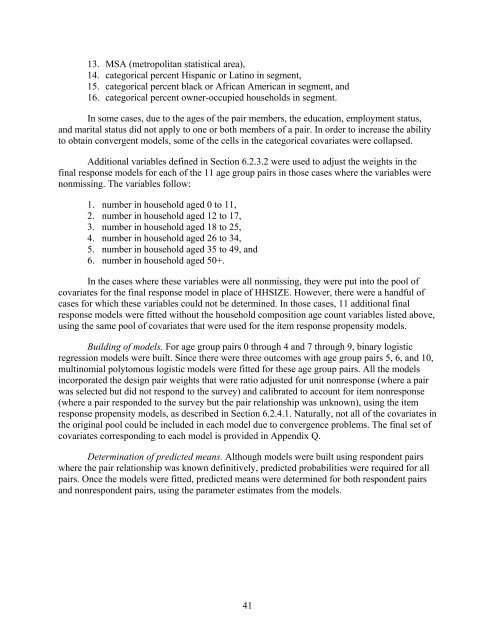Questionnaire Dwelling Unit-Level and Person Pair-Level Sampling ...
Questionnaire Dwelling Unit-Level and Person Pair-Level Sampling ...
Questionnaire Dwelling Unit-Level and Person Pair-Level Sampling ...
Create successful ePaper yourself
Turn your PDF publications into a flip-book with our unique Google optimized e-Paper software.
13. MSA (metropolitan statistical area),<br />
14. categorical percent Hispanic or Latino in segment,<br />
15. categorical percent black or African American in segment, <strong>and</strong><br />
16. categorical percent owner-occupied households in segment.<br />
In some cases, due to the ages of the pair members, the education, employment status,<br />
<strong>and</strong> marital status did not apply to one or both members of a pair. In order to increase the ability<br />
to obtain convergent models, some of the cells in the categorical covariates were collapsed.<br />
Additional variables defined in Section 6.2.3.2 were used to adjust the weights in the<br />
final response models for each of the 11 age group pairs in those cases where the variables were<br />
nonmissing. The variables follow:<br />
1. number in household aged 0 to 11,<br />
2. number in household aged 12 to 17,<br />
3. number in household aged 18 to 25,<br />
4. number in household aged 26 to 34,<br />
5. number in household aged 35 to 49, <strong>and</strong><br />
6. number in household aged 50+.<br />
In the cases where these variables were all nonmissing, they were put into the pool of<br />
covariates for the final response model in place of HHSIZE. However, there were a h<strong>and</strong>ful of<br />
cases for which these variables could not be determined. In those cases, 11 additional final<br />
response models were fitted without the household composition age count variables listed above,<br />
using the same pool of covariates that were used for the item response propensity models.<br />
Building of models. For age group pairs 0 through 4 <strong>and</strong> 7 through 9, binary logistic<br />
regression models were built. Since there were three outcomes with age group pairs 5, 6, <strong>and</strong> 10,<br />
multinomial polytomous logistic models were fitted for these age group pairs. All the models<br />
incorporated the design pair weights that were ratio adjusted for unit nonresponse (where a pair<br />
was selected but did not respond to the survey) <strong>and</strong> calibrated to account for item nonresponse<br />
(where a pair responded to the survey but the pair relationship was unknown), using the item<br />
response propensity models, as described in Section 6.2.4.1. Naturally, not all of the covariates in<br />
the original pool could be included in each model due to convergence problems. The final set of<br />
covariates corresponding to each model is provided in Appendix Q.<br />
Determination of predicted means. Although models were built using respondent pairs<br />
where the pair relationship was known definitively, predicted probabilities were required for all<br />
pairs. Once the models were fitted, predicted means were determined for both respondent pairs<br />
<strong>and</strong> nonrespondent pairs, using the parameter estimates from the models.<br />
41
















